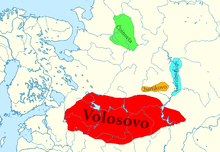
Back Cultura Vólossovo Catalan Cultura Volosovo Spanish Volosovon kulttuuri Finnish Culture de Volosovo French Волосовоса культура KV Volosovocultuur Dutch Волосовская культура Russian Volosovokulturen Swedish Волосівська культура Ukrainian
 | |
| Geographical range | North-Central Russia, Volga region |
|---|---|
| Period | Neolithic to early Bronze Age |
| Dates | 4000-2000 BC or 1800-1500 BC |
| Major sites | Volga, Kama, Oka River, Veletma River |
| Preceded by | Balakhna culture, Lyalovo culture[1] |
| Followed by | Garino-Bor, Netted Ware culture[2] |
The Volosovo culture (Russian: Волосовская культура, romanized: Volosovskaya kul'tura) is an archaeological culture that followed the Neolithic Pit-marked pottery culture (Balakhna). The archaeological assemblage identified with this culture is related to finds from the middle Volga and Kama basin.[3]
The Volosovo culture emerged sometime between the third and fourth millennium B.C. and lasted until the second millennium BC.[4] The people of the Volosovo culture has been described as forest foragers.[5][6]
- ^ Bryant, Edwin Francis; Patton, Laurie L. (2005). The Indo-Aryan Controversy: Evidence and Inference in Indian History. Oxon: Psychology Press. p. 127. ISBN 0-7007-1462-6.
- ^ Mailhammer, Robert (2015). The Linguistic Roots of Europe. Copenhagen: Museum Tusculanum Press. p. 84. ISBN 9788763542098.
- ^ Dolukhanov, Pavel (2013). The Early Slavs: Eastern Europe from the Initial Settlement to the Kievan Rus. Oxon: Routledge. pp. 88–89. ISBN 9780582236189.
- ^ Kir'iak, M. A. (2007). Early Art of the Northern Far East: The Stone Age. Anchorage: U.S. Department of the Interior, National Park Service, Shared Beringian Heritage Program. p. 96. ISBN 9780160822223.
- ^ Anthony, David W. (2007). The Horse, the Wheel, and Language: How Bronze-Age Riders from the Eurasian Steppes Shaped the Modern World. Princeton, NJ: Princeton University Press. p. 382. ISBN 9780691058870.
- ^ Hanks, Bryan K.; Linduff, Katheryn M. (2009). Social Complexity in Prehistoric Eurasia: Monuments, Metals and Mobility. New York: Cambridge University Press. pp. 308. ISBN 9780521517126.
© MMXXIII Rich X Search. We shall prevail. All rights reserved. Rich X Search